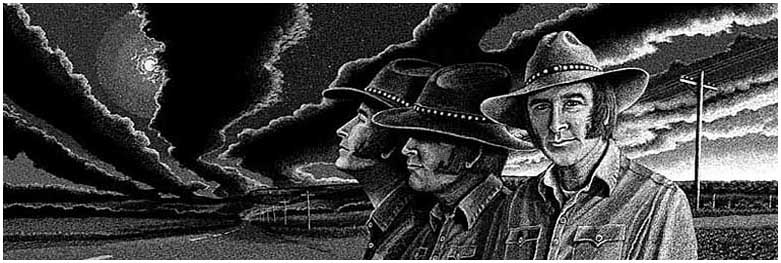|
"Odds are, you could find yourself, here in this passage between moonlight and dawn. Seeing change move through the backwater eddies and the mainstream flows of the world around you. Thinking about things that have already been and might yet be. Being intimate with each moment and in that labor of love, you will grow through the fleeting moments you have left to become, richly alive. There is a place where streets meet, highways." From the studio artbook Roadsongs, A Journey Into the Life and Mindscapes of an American Artist |
 |
|
The purpose of this website is to present the studio artbook Roadsongs, A Journey Into the Life and Mindscapes of an American Artist and
to catalog the 30 multiple-original artist-hand-made relief etching
images that form the inspiratioal backbone of this tour-de-force
coffeetable masterwork by artist, photographer, poet, author, and
composer, Malcolm Graeme Childers.
You can view Malcolm's available and archived fine original print folios by clicking here on Etching Galleries or listen to excerpts of anyone of four mindscapes by clicking here on The Mindscape. Available works can be ordered by clicking on ordering here or at any gallery image enlargement site. The Real Earth manages the fine art of Malcolm Childers. We can be contacted by email at roadsongs@patriotpost.us or by text at 970 985 5369. All of Malcolm Graeme Childers' art and his texts on this website are Copyrighted, |
|
Fine Art Landscape Web log
|
|
The artist invites an online dialogue with those who wish to bring their insights, knowledge, questions, and critique of the current topic below. We will publish your reactions below in the interest of stimulating the greater human knowledge base for the good of our readers. If you do not want your email thoughts to be published on this website, please indicate your preference at the beginning of your email. Only your initials and location will identify your comments. We welcome your comments, even if you choose not to publish them. Click on the email link above to send your response. Thank you for your interest. "The Fine Art Landscape in the Growth of Human Consciousness." A Philosophical Hypothesis by Malcolm Graeme Childers I sense that the landscape in art history and its modern offspring, fine art landscape photography, are indelibly linked to the larger growth saga of human consciousness. To get a broader view of the historic development of the fine art landscape, look at a timeline in any good art history book. Human art expression has had an animistic focus for at least the first 80% of the history of modern Homo Sapiens. Even a cursory examination of the topic will show that the dedicated art landscape is extreme a latecomer in the overall history of human aesthetic expression. The human figure along with its animal companions has been the prime focus of human artistic expression ever since we first began painting or pecking images on the walls of caves or fashioning idols and fertility icons from stone and clay, a span of in excess of 80,000 years. Among the earliest surviving examples of a western landscape is a fresco of a coastal scene with swimmers. It dates from the fifth century BC and is located in the early Greco Roman settlement of Paestum in Southern Italy. There are vestigial garden scenes on the wall of Pompeii that date from the first century AD. During the Romanesque, mosaics dominated wall art. Mosaics, though capable of depicting landscape, were by their very nature more conducive to figurative art. The landscape in western culture reappeared with the rebirth of the fresco usually as filler behind a main figure or figures. Oriental artists may have produced their first dedicated landscape centuries before their Occidental counterparts. If so, the exact dates are obscure. The first dedicated fine art landscape in Western Culture, however, has an exact date. On the 5th of August 1473, Leonardo Da Vinci did an ink drawing of a vista in the Arno Valley. His sketch, Day of St. Mary of the Snows, was the first time anyone in the western hemisphere had devoted the entire content of an art expression exclusively to landscape. His sketch was just another first for the Renaissance progenitor of so many unique ideas. Gradually, since that first drawing, Occidental artists began to see, not only just the places they lived in, but also the world in general as a subject worthy of their efforts. The Renaissance gave western culture other acts of gratuitous landscape awareness. Patriarch, the noble philosopher/writer, is generally considered to be the first man to have climbed a mountain simply because it was there. A fascinating new edge on human thought when you consider that the only reason such an endeavor would have been undertaken prior to Patriarch, would have been to reconnoiter the land you were planning to conquer.
I want to initiate thought, discussion, and debate. I will be developing and adding to my thoughts as your feedback and my schedule allow. Thank you for whatever you bring to the discussion. Respectfully, Malcolm Childers |